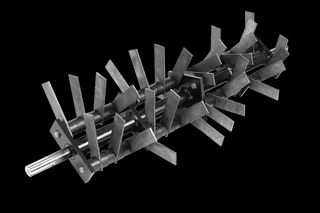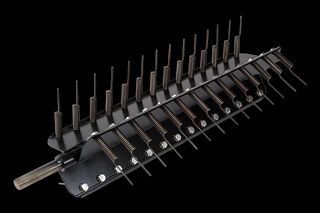How to manage thatch in lawns
Thatch can make your lawn less durable, not strong enough for sports and other activities and – in a worst-case scenario – wither and die. Here are Husqvarna’s tips on thatch-removal and thatch-removal tools such as scarifiers.
Thatch is the layer of dead plant material that develops between the zone of green vegetation and the soil surface. If your lawn is ten years old, you most likely already have a 30-40 millimetre thick layer of thatch.
Where does thatch come from?
Thatch develops in your lawn when organic debris is produced faster than it can be broken down. This happens for a number of reasons. Some common causes are:
- Too high density of the turf, caused by the use of modern, super-efficient grass varieties
- Low biological activity due to nutrient-poor soil with low humus levels in the growth layer of the grass
- A too low pH-level, often caused by using fertiliser with high acidity
- Too large amounts of grass – larger than what the microlife can handle – often caused by overfertilisation

When is thatch a problem?
A thin layer of thatch can have beneficial effects on your lawn, providing it with a layer of insulation and resilience. But if the thatch layer exceeds 5 millimetres the function of the grass changes. As the water permeability gets worse, the roots grow closer to the surface and the root mass and the oxygen exchange decreases. As a result the grass becomes less durable and can no longer withstand sports and other activities. The risk of the grass dying increases and some grass varieties cannot survive.
The perks of removing thatch
Removing thatch gives a dense, competitive lawn with better oxygen exchange, greater water permeability, fewer weeds and a reduced risk of disease. This makes the grass much more durable, since the root mass grows and the roots grow deeper.
When to get rid of thatch?
If you live in a part of the world where seasons change, thatch removal is best done in late spring or early autumn, when the grass is growing well. Avoid removing thatch in early spring or during dry periods, since the microlife is intensive then and the unprotected roots are at a greater risk of drying out.
Removing the thatch
Before you start dethatching, or scarifying to use another word, cut the lawn short and collect the clippings. Then choose the machine and the tools that work best for your type of lawn. For grass areas under 5,000 square metres, a scarifier with or without a collector is almost always used. For larger grass areas, use a tow-behind scarifying unit. These normally have direct, integrated collectors.
Flail blades and spring tines
A scarifier can be equipped with flail blades, which remove the thatch effectively. Their rotating blades should not go deeper into the soil than 1 to 2 millimetres, so the grass is not damaged. On sensitive areas, such as ornamental lawns, you can use the gentler method with spring tines, which should also not go deeper into the soil than 1 to 2 millimetres. The effect is less with flail blades.
Delta blades
You should use delta blades to cut off the lateral roots of the grass and to fight broadleaf weeds effectively. These blades should not go deeper into the soil than 7-10 millimetres but they are very effective. In warmer countries, scarifying with delta blades is an important way of improving the effect of watering. It ensures that the water penetrates to the roots of the grass.

After scarifying
When you’ve finished dethatching your lawn, remove the material that’s been pulled up. You can compost it, though it will take longer than other garden debris to break down, or put it in the yard waste collection. Then, for best results, it is a good idea to fertilize, top dress and water the lawn.












